We were drawn to this walk by the Northumberland National Park Poems in the Air project. Earlier this summer, we’d listened to Simon Armitage recounting his Proposal Stone poem on the Simonside Hills – a quite magical experience, so we were keen to explore more of these walks.
On a extraordinarily perfect autumnal day last week we set out to walk to Old Middleton to find the deserted village, and hear another Simon Armitage poem. We parked the car near Middleton Farm, and walked up the track, past berry-laden trees and the curious cattle …
We parked the car near Middleton Farm, and walked up the track, past berry-laden trees and the curious cattle … This is a beautiful spot – but I wouldn’t care to live here. Just look at these pylons dominating the farm (tucked away at its feet)!
This is a beautiful spot – but I wouldn’t care to live here. Just look at these pylons dominating the farm (tucked away at its feet)! We are all too familiar with complaints about wind farms in Northumberland, but I’ve never heard anyone moan about the pylons, and when you meet them like this, you do wonder why ever not …
We are all too familiar with complaints about wind farms in Northumberland, but I’ve never heard anyone moan about the pylons, and when you meet them like this, you do wonder why ever not … But never mind the pylons and the current disputes raging about how we mark the landscape – we were here to find habitations that long pre-dated these arguments. Stephen found them on his phone first …
But never mind the pylons and the current disputes raging about how we mark the landscape – we were here to find habitations that long pre-dated these arguments. Stephen found them on his phone first … Just a little way on, and we saw the old enclosures …
Just a little way on, and we saw the old enclosures … And got our first glimpse of these deserted buildings …
And got our first glimpse of these deserted buildings … It’s not unusual to find old barns and outhouses that have fallen into disrepair and been abandoned, but what is strange about this place, is the house nearby – hidden by the overgrown trees.
It’s not unusual to find old barns and outhouses that have fallen into disrepair and been abandoned, but what is strange about this place, is the house nearby – hidden by the overgrown trees. We couldn’t resist looking inside … the overgrown trees making the pathway difficult …
We couldn’t resist looking inside … the overgrown trees making the pathway difficult … Look down amid the overgrown nettles at those muddy hoof prints – it’s clearly a home for the local sheep now …
Look down amid the overgrown nettles at those muddy hoof prints – it’s clearly a home for the local sheep now … Where the nettles haven’t taken over completely …
Where the nettles haven’t taken over completely …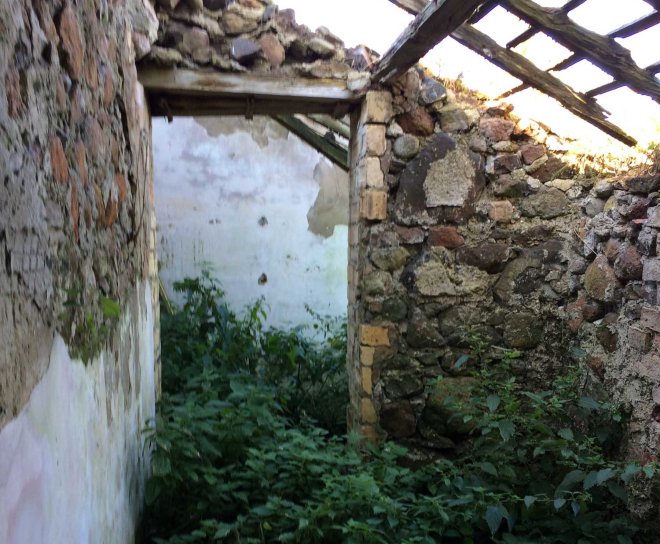 We peered in gingerly …
We peered in gingerly … Not sure what we’d find …
Not sure what we’d find … The old range …
The old range … And the water pipes connecting to nothing now …
And the water pipes connecting to nothing now … But once (presumably) they led to this bath …
But once (presumably) they led to this bath …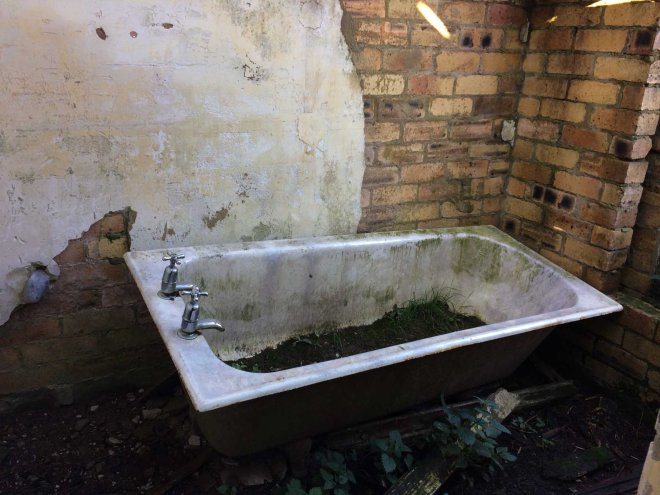 And the toilet …
And the toilet … Look up, and there’s the water tank. Ooh dear, it does look very dodgy ….
Look up, and there’s the water tank. Ooh dear, it does look very dodgy …. As do other things …
As do other things … In fact, it’s probably best not to look up …
In fact, it’s probably best not to look up … In many places the plaster has come off, but the mid twentieth century fireplace is still there in what must have been the living room …
In many places the plaster has come off, but the mid twentieth century fireplace is still there in what must have been the living room … And another older (and in my opinion prettier) fireplace in the single bedroom …
And another older (and in my opinion prettier) fireplace in the single bedroom … On sunny days like this, how fine it is to look out of this bedroom …
On sunny days like this, how fine it is to look out of this bedroom … What views from this cottage …
What views from this cottage … And the sheep glimpsed outside …
And the sheep glimpsed outside … The old electricity meter, all rusted up now …
The old electricity meter, all rusted up now … It feels intrusive – especially when you come across objects like this odd shoe …
It feels intrusive – especially when you come across objects like this odd shoe … So we left the cottage and walked back to explore the old barns …
So we left the cottage and walked back to explore the old barns … Overgrown with nettles and small trees …
Overgrown with nettles and small trees … To peer through the little window at the sheep …
To peer through the little window at the sheep … And admire the quality of the quoins in the stone doorway …
And admire the quality of the quoins in the stone doorway … Before settling down to listen to Simon Armitage, the curious sheep warily coming to watch us …
Before settling down to listen to Simon Armitage, the curious sheep warily coming to watch us …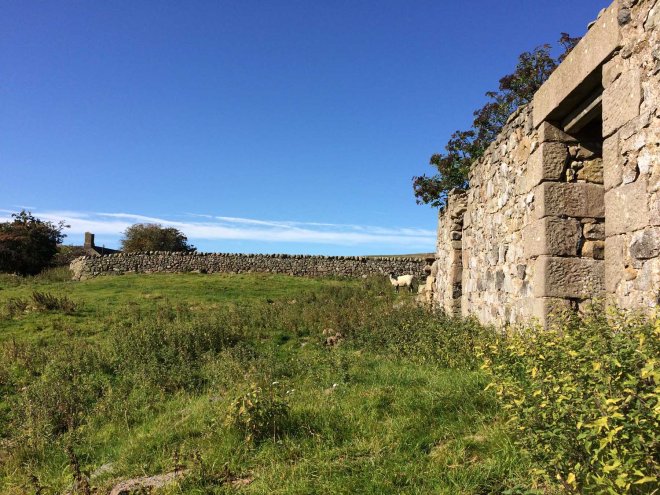
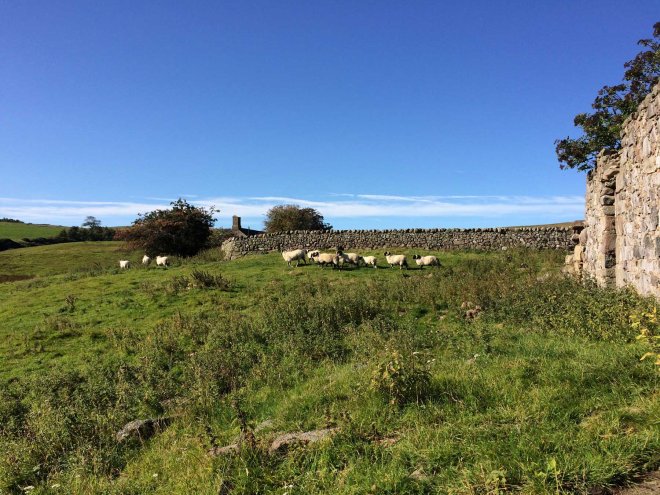 I can’t remember the poem, nor did we write it down (that would spoil it for others rather), but I can tell you that he spoke of abandonment and renaturing.
I can’t remember the poem, nor did we write it down (that would spoil it for others rather), but I can tell you that he spoke of abandonment and renaturing.
“We are tenants only …” Too right, Simon – applicable to so much that we think we control in our everyday lives. Villagers have fled their homes in this Northumbrian/Borderland area for many centuries. The constant raiding in the sixteenth century (Scots and English marauders pillaging over their borders) took a huge toll on the ordinary farming families trying to eke a living out of this land.
Villagers have fled their homes in this Northumbrian/Borderland area for many centuries. The constant raiding in the sixteenth century (Scots and English marauders pillaging over their borders) took a huge toll on the ordinary farming families trying to eke a living out of this land.
But this cottage was clearly inhabited in the last century so we were curious to know more about Old Middleton. Very little is written about it, but I did find this interesting little reference in Edward Baker’s “Walking the Cheviots”.
“Only the earthworks of this abandoned village are visible today. Originally it comprised of two rows of cottages north and south of a village green. In 1580 Thomas Gray of Chillingham had eleven tenants living there. Today only a ruined shepherd’s cottage marks the site. These abandoned villages are often the result of farm mechanisation causing a drop in required manpower, resulting in rural depopulation.”
We looked around at this beautiful place – green fertile lands, trees, water – and wondered about the people who had to leave. Casually – as though dropped in a rush – somebody had left this curious cast-iron object on the ground near where we were sitting.
Casually – as though dropped in a rush – somebody had left this curious cast-iron object on the ground near where we were sitting. We had no idea what it is, but it was clearly marked: R.A.Lister, Dursley, according to Wikipedia makers of agricultural equipment. Somehow the rejection of this object made even more poignant the ending of the agricultural enterprise that was Old Middleton.
We had no idea what it is, but it was clearly marked: R.A.Lister, Dursley, according to Wikipedia makers of agricultural equipment. Somehow the rejection of this object made even more poignant the ending of the agricultural enterprise that was Old Middleton. We left Old Middleton and walked on – our route highlighted in red on the map below.
We left Old Middleton and walked on – our route highlighted in red on the map below. As we looked back at these deserted buildings, we could see strip farming marks highlighted in the fields, showing where in the middle ages this land would have been farmed under the open-field system.
As we looked back at these deserted buildings, we could see strip farming marks highlighted in the fields, showing where in the middle ages this land would have been farmed under the open-field system.  Our route took us along the hill slope, through a large field of very noisy cattle …
Our route took us along the hill slope, through a large field of very noisy cattle … Who – most disturbingly – were walking parallel to us, lowing furiously as though gathering for a meet …
Who – most disturbingly – were walking parallel to us, lowing furiously as though gathering for a meet … The track was extremely boggy in places …
The track was extremely boggy in places … So we were glad when we escaped the noisy cattle and the marshy ground, and soon found ourselves on better terrrain …
So we were glad when we escaped the noisy cattle and the marshy ground, and soon found ourselves on better terrrain …  and heading down to the treeline …
and heading down to the treeline … A brief glimpse of the beautiful Coldgate Water in the valley below …
A brief glimpse of the beautiful Coldgate Water in the valley below … Our path took us past a little lake (map consultation taking place here) …
Our path took us past a little lake (map consultation taking place here) … No Swimming!
No Swimming! And down down down ….
And down down down …. To the Coldgate Water …
To the Coldgate Water … The trouble was – it was much deeper than we had expected!
The trouble was – it was much deeper than we had expected! Or had the map-reader brought us to the wrong crossing … hmmm. Either way, we had to cross, and what else to do, but strip off our sox and walking boots and paddle over barefoot ….
Or had the map-reader brought us to the wrong crossing … hmmm. Either way, we had to cross, and what else to do, but strip off our sox and walking boots and paddle over barefoot ….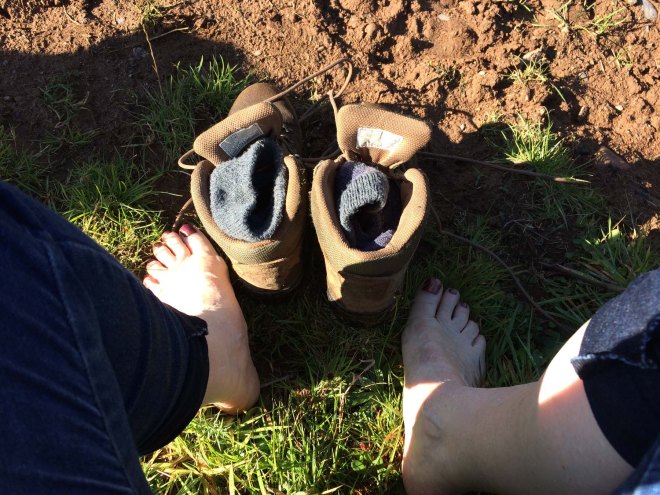 It was very beautiful ….
It was very beautiful …. But very very cold! I guess it isn’t named the Coldgate Water for nothing …
But very very cold! I guess it isn’t named the Coldgate Water for nothing … Ah, but the pleasure of sunning your wet feet when you’ve crossed the stream!
Ah, but the pleasure of sunning your wet feet when you’ve crossed the stream! Especially when Stephen realises he has some kitchen roll to dry our feet with. Softies aren’t we!
Especially when Stephen realises he has some kitchen roll to dry our feet with. Softies aren’t we! The other side of the bank the path was tricky – muddy (trampled by the cattle) and seriously overgrown …
The other side of the bank the path was tricky – muddy (trampled by the cattle) and seriously overgrown … So – imagine our pleasure when we came out into the plain of the Happy Valley!
So – imagine our pleasure when we came out into the plain of the Happy Valley! Much easier walking here … (even if the defaced waymarker was no help) …
Much easier walking here … (even if the defaced waymarker was no help) … Through dappled woods …
Through dappled woods …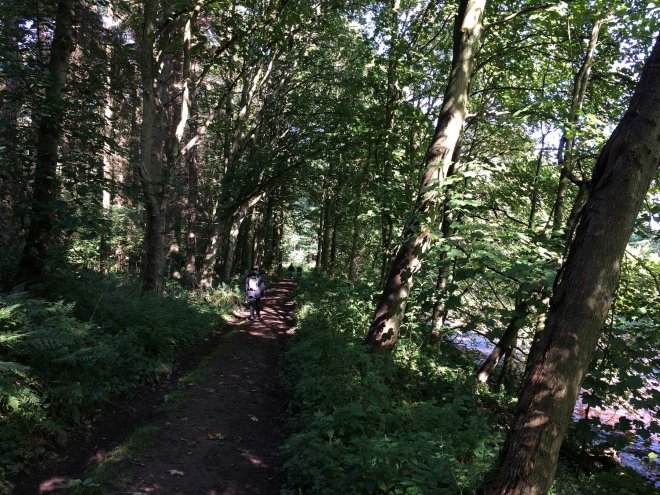 At times, it did appear that we were being watched … Or is that face in the tree just my imagination?
At times, it did appear that we were being watched … Or is that face in the tree just my imagination?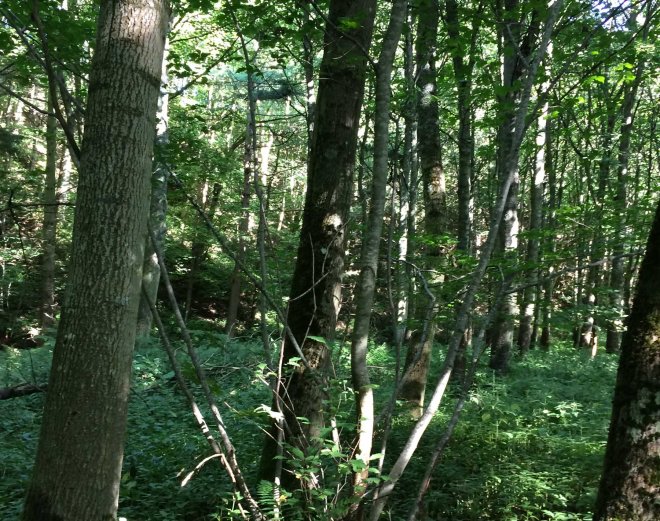 Then we crossed back over the Coldgate Water – thank goodness a proper bridge here …
Then we crossed back over the Coldgate Water – thank goodness a proper bridge here … Past the thoughtfully placed bench …
Past the thoughtfully placed bench … And back to Middleton Farm and our little white car!
And back to Middleton Farm and our little white car! It was a glorious walk, but I cannot help feeling sad that people had to leave their homes in a place called the Happy Valley.
It was a glorious walk, but I cannot help feeling sad that people had to leave their homes in a place called the Happy Valley.

This was so interesting I just had to look the place up on Google maps. Pretty sure I found the abandoned house you went in. Further east I thought I could see a number of house foundations (the old village?) and yes, can see the farming strips. (Have just been on Ancestry to see if there was a census return in 1841 for this village. Not found anything yet but will let you know if there is.) It is so strange entering what was someone’s home, almost as if you’re intruding. Perhaps the ghosts are watching you …..
LikeLike
How interesting your researches sound, Mandy! Yes, I think you found the rest of the village (which we didn’t walk to) – it would appear that they were abandoned long before the cottage we visited. I shall be most interested to hear if you find anything further. Definitely ghosts accompanying us on this walk!
LikeLike
What a wonderful place to visit, thank you for sharing.
LikeLike
So glad you enjoyed it, Cathy – it was a most interesting place.
LikeLike
Gosh it is easy to forget that the development of modern farming practices had such profound effects on where so many people lived and worked. It quite literally changed the landscape. Another great walk, thank you.
LikeLike
Thank you, Rebecca – glad you enjoyed this walk 🙂 I completely agree that we so easily forget about the impact of farming changes. The world today understands bigger as better, and the little farmer is pushed out. What really struck us here was how richly blessed this place was with good pasture land and fresh water. And also the irony that this cottage would be a very desirable home for people now with cars to drive to their work place …
LikeLike
J > I do so enjoy your ambulatory-photo-journalism! We, too, like to delve into the fourth dimension of the landscape we explore. Poring over a map, looking for somewhere to walk, we’d be drawn instinctively to places like Middleton, where the elevation is high, countours contort, there is a cluster of historical occupation, and paths and lanes radiate – yet not modern roads.
LikeLike
There is something about the human contribution to the landscape, isn’t there, Jonathan? T.S Eliot talked about the accretions of prayer at Little Gidding (“You are here to kneel where prayer has been valid”), and I think it’s true of human lives and the landscape in general. I would expect there to be many deserted crofts in your landscape – all with a poignant story to tell. They touch some inner chord of sympathy in the shared human condition.
LikeLike
What a super interesting place to come across and get to explore. I have recently been learning more about losses that resulted in the introduction of motor run farm equipment it’s unimaginable to think how quickly people’s lives changed as a result.
LikeLike
Yes, it was an amazing place to happen upon – and I agree there has been such change in peoples’ lives. It was heartbreaking to think of people having to leave this lovely home.
LikeLike
I showed the mystery object to my Dad (who was born and raised in working class Northumberland) and he thinks it’s a pump housing. He says ‘Lister engines’ were well known back in the day.
LikeLike
Please thank your dad for that information! It would make sense to leave pumping equipment that might not be usable in another situation. All adds to the story of the place. I’m hoping to revisit – it would be intriguing to see how much has changed since we visited in 2017.
LikeLike